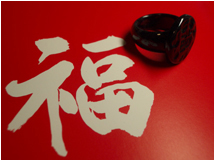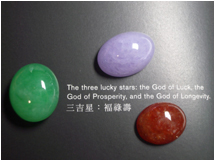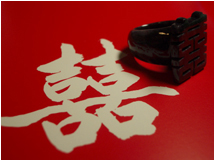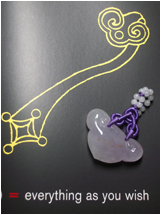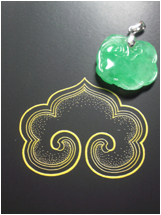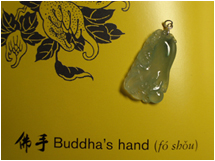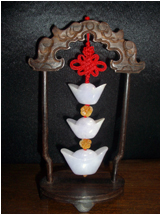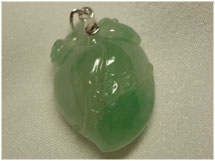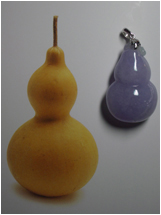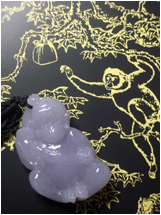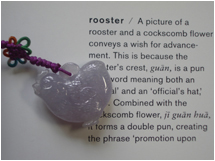
|
|
![]()
![]()
| - Agnes' Tips | |
| - | Amber |
| - | Amber Jewelry |
| - | Burmese Jadeite |
| - | Bangles |
| - | Bracelets |
| - | Brooches |
| - | Charms |
| - | Collectables |
| - | Earrings |
| - | Necklaces |
| - | Pendants |
| - | Rings |
| - | Chinese Nephrite |
| - | Black Jade |
| - | Green Jade |
| - | White Jade |
| - | Pearls |
| - | Pearl Earrings |
| - | Pearl Necklaces |
| - | Pearl Pendant |
| - | Pearl Rings |
| - | Unique Designs |
| - | Jade Designs |
| - | Unique Gems |
| - | Gem Jewelry |
To know about jade or to possess a
piece of jade, you cannot avoid knowing more about Chinese culture.
For example, many features crafted on jade stones might reflect
thousands of years of Chinese culture. We might see carvings of
a gourd, a scepter or even some Chinese characters or Chinese mythical
animals on jade jewelry but what do they actually mean? |
Good Fortune and auspicious thought
are central to all aspects of Chinese life and culture. The Chinese
believe that by layering their lives with lucky objects and images,
they increase their chances of a happy and prosperous existence.
Over the centuries, a symbolic language has evolved that expresses
these ideas in art, craft, architecture, language, and everyday
objects. Lucky words and phrases were used to create an environment
protected from misfortune, bad omens, and disaster. – From
Five-Fold Happiness |
|
| top |
|
The character fu represents ‘good
fortune,’ ‘blessing,’ or ‘luck.’ Since
ancient times, the desire for fu has been
widespread, and its popularity is reflected in many applications
of decorative arts, architecture, and clothing. Beginning in the
Ming dynasty (1368-1644), a large fu character
would often be found at entranceways of buildings to bring a continuous
flow of good fortune through the door. Phrases and pictures express
this thought, such as ‘the God of Luck brings fortune,’
fu xing gao zhao, and ‘an abundance
of luck and long life,’ duo fu duo shou.
Symbols for luck include the bat, the ru yi
scepter, the fruit known as Buddha’s hand and the God of Luck.
– From Five-Fold Happiness |
|
||
The three concepts fu lu
shou are frequently grouped together and represented
by their corresponding deities – the God of Luck, the God
of Prosperity, and the God of Longevity. These three figures are
highly revered, and many Chinese throughout the world display their
status or images in their homes. A multitude of rebuses have been
created to represent the three values in combination. Their importance
is embodied in the saying ‘In Heaven there are three lucky
stars, on Earth there are fu, lu, shou.’
– From Five-Fold Happiness |
|
Double happiness is synonymous with
one of life’s most important celebrations – marriage.
Consequently, it is related to the wish for fertility, and is often
seen at wedding banquets. The good luck that surrounds this character
has made it ubiquitous, and it commonly appears on bowls, glasses,
vases, product packaging, and other everyday objects. The character
for double happiness is traditionally displayed as a cutout or inscription
on red paper, red being a lucky colour. – From Five-Fold
Happiness |
|
The dragon, long,
is a benevolent and mystical creature that was once widely worshipped
by the common people to bring rain and good harvests. Thus, the
dragon is an auspicious symbol of protection and fortune. The dragon
has power to be either visible or invisible and inhabits the skies,
seas, rivers, mist, and rain. Consequently, the dragon is often
depicted flying among clouds. The character long
is inscribed on oracle bones dating back to the Shang dynasty (ca.1600-ca.1027
B.C.). From the Han dynasty (206 B.C. – A.D. 220) onward,
the dragon was adopted as a symbol for the emperor and became a
potent emblem of imperial power….The appearance of the dragon
was seen as an omen of good fortune and often marked the birth of
a great man or dynasty. The dragon is said to have shown itself
just prior to the birth of Confucius in 551 B.C. – From
Five-Fold Happiness |
|
The ru yi
scepter is a short sword that symbolizes ‘everything as you
wish.’ It is the first of the eight Buddhist treasures, and
its shape is said to have been derived from the magic fungus of
immortality, ling zhi. When given as a
present, the scepter conveys wishes for good fortune and prosperity.
The earliest scepters, made of iron, were used as weapons. Later
versions were in gold, silver, jade, amber, porcelain, bone or wood.
An image of the ru yi combined with a
vase, ping, represents peace, forms the rebus ping an ru
yi, meaning ‘may you have peace and everything
as you wish.’ When the Gods of Peace and Harmony, he
he er xian, are shown holding a ru yi,
it symbolizes ‘harmony and everything as you wish.’
he he ru yi. – From Five-Fold
Happiness |
|
Cloud / Because of the word for ‘cloud,’ yun and the word for ‘good luck,’, sounds similar, this symbol is often referred to as the ‘auspicious cloud,’ xiang yun. A typical auspicious cloud is give coloured, wu se yun, and represents five layers of fortune and happiness. The cloud has become a popular motif in architecture, textile designs, and everyday objects. When it is repeated in a pattern, it symbolizes never-ending fortune. The stylized rendering of the cloud motif is similar in form to the fungus of immortality, ling zhi, and the ru yi, scepter, Numerous gods and immortals used the cloud as a vehicle on which they traveled. – From Five-Fold Happiness |
|
Buddha’s hand / The finger-shaped
citron known as Buddha’s hand (Citrus medica), fo
shou, stands for luck and happiness. The first character,
fo, meaning ‘Buddha,’ sounds
much like fu, the word for ‘luck.’
An image of a Buddha’s hand together with a peach and a pomegranate
signifies ‘may you have an abundance of luck, longevity, and
children.’ The peach symbolizes longevity, the pomegranate
fertility. The fruit is also a symbol of Buddhism because of upturned
fingers resemble the classic position of a Buddha’s hand.
– From Five-Fold Happiness |
|
Three ingots / A popular symbol of
prosperity, yuan bao are hat-shaped gold
and silver ingots used as money in ancient China. Scholars who passed
the imperial examinations with the highest marks were referred to
as jie yuan, hui yuan,
and zhuang yuan, collectively referred
to as the ‘three yuans.’ Because the word for ingots
also contains yuan, a picture of three
ingots creates a rebus for the ‘three yuans’, san
yuan, making it a symbol of status and hour. –
From Five-Fold Happiness |
|
Bamboo / Known for its durability and
resilience through all the seasons, bamboo, which never loses its
leaves, is a symbol for longevity and for courage in the midst of
adversity. In ancient times, it was described as ‘not stiff,
no soft, not grass, and not wood.’ Bamboo, pine and plum form
a group known as ‘the three friends,’ since the pine
and bamboo flourish year-round and the plum tree blossoms in winter.
– From Five-Fold Happiness |
|
Peach / Use of the peach as a symbol
of longevity originated over two thousand years ago. ‘Longevity
peaches’ are steamed buns made a dough shaped like a peach
and filled with red bean, date or lotus-seed paste….Not only
the fruit but also the wood and blossoms of the peach tree are symbolic.
Bad spirits feared peachwood and so peachwood charms were often
hung outside doors or gates to keep them away….Peach pits
were carved into little amulets and given to children to protect
them and ensure long life. – From Five-Fold Happiness |
|
||
The gourd is said to embody heaven
and earth, and to contain spiritual energy that wards of evil spirits.
It is often hung for protection above door or window, at the head
of a bed, or in a vehicle. One of the Taoist treasures, the gourd,
hu lu, is also a vessel for magic elixirs.
Li Tie Guai, one of the Eight Immortals and a master magician, carries
the gourd as his treasure. – From Five-Fold Happiness |
|
This is the Chinese year of Monkey,
which is always marked as the most soulful animal on earth. |
|
Rooster / A picture of rooster and
a cockscomb flower conveys a wish for advancement. This is because
the rooster’s crest, guan, is a
pun on a word meaning both an ‘official’ and an ‘official’s
hat,’ guan. Combined with the cockscomb
flower, ji guan hua, it forms a double
pun, creating the phrase ‘promotion upon promotion,’
guan shang jia guan. The rooster is also
seen as an auspicious creature that can ward off evil spirits. –
From Five-Fold Happiness |
|
Spider / Considered a good omen for
happiness, the spider, xi zi, sounds identical
to ‘happiness,’ xi. It has
come to be known as the ‘happy insect,’ and a picture
of a spider dropping from the center of its web is a rebus for ‘happiness
dropping from the sky,’ xing cong tian jiang.
The web resembles ancient money, because it is round on the outside
and square on the inside. The square hole in the web is considered
an eye and therefore expresses ‘happiness before one’s
eyes.’ xi zai yan qian. - From
Five-Fold Happiness |
|
Goldfish / The characters for goldfish, jin yu, sounds identical to those meaning
‘abundance of gold,’ making the goldfish a frequent
symbol of wealth and abundance. One of the most popular New Year’s
image is a child holding large goldfish and a lotus flower, he,
which brings both wealth and harmony, he….A
bowl full of goldfish, jin yu man tang,
means ‘may gold and jade fill your house,’ because the
pronunciation of ‘fish,’ yu is the same except for tone to ‘jade’, yu.
- From Five-Fold Happiness |
|
